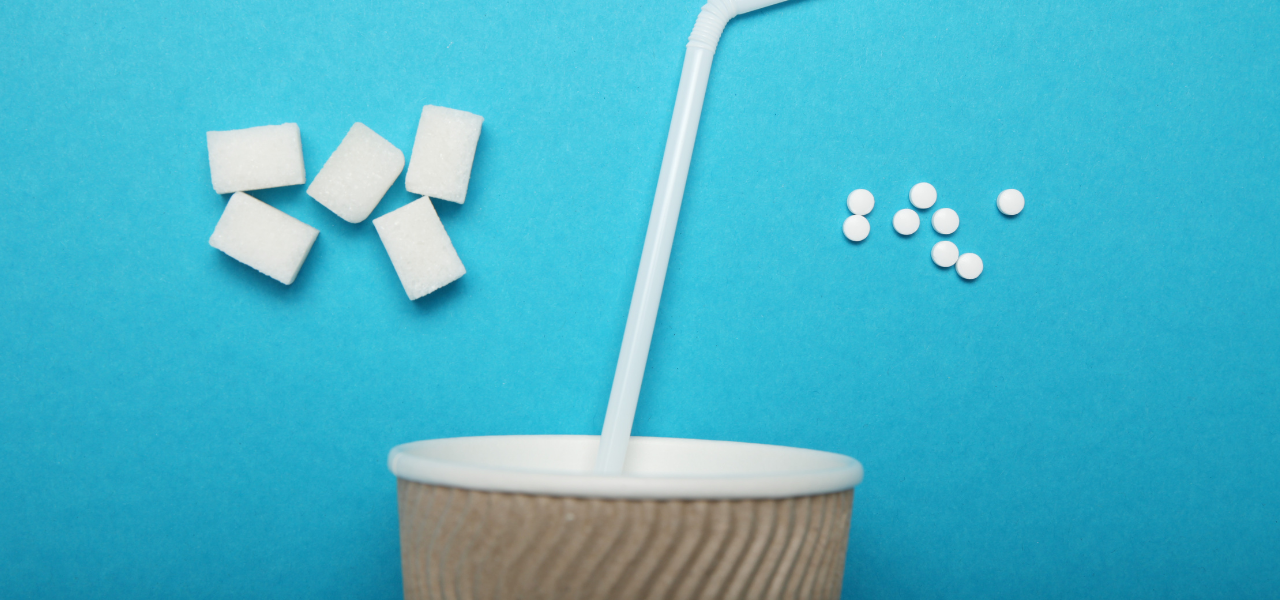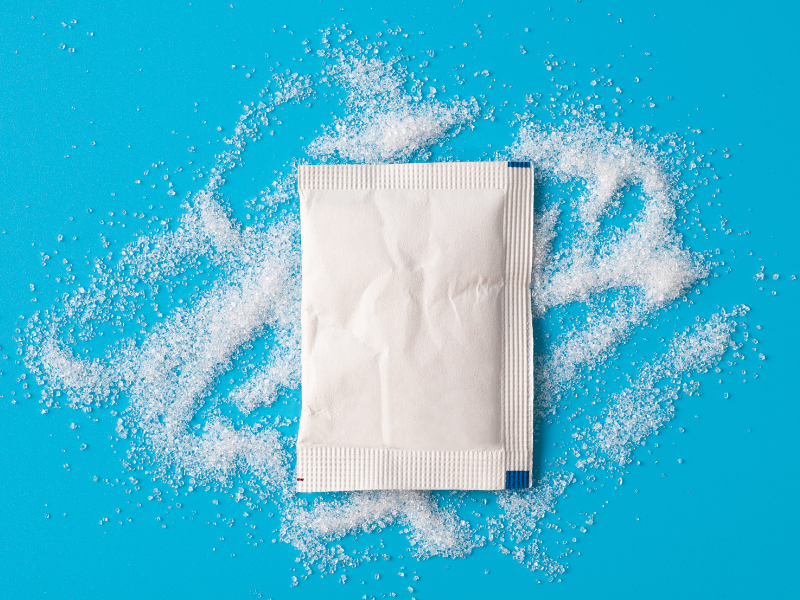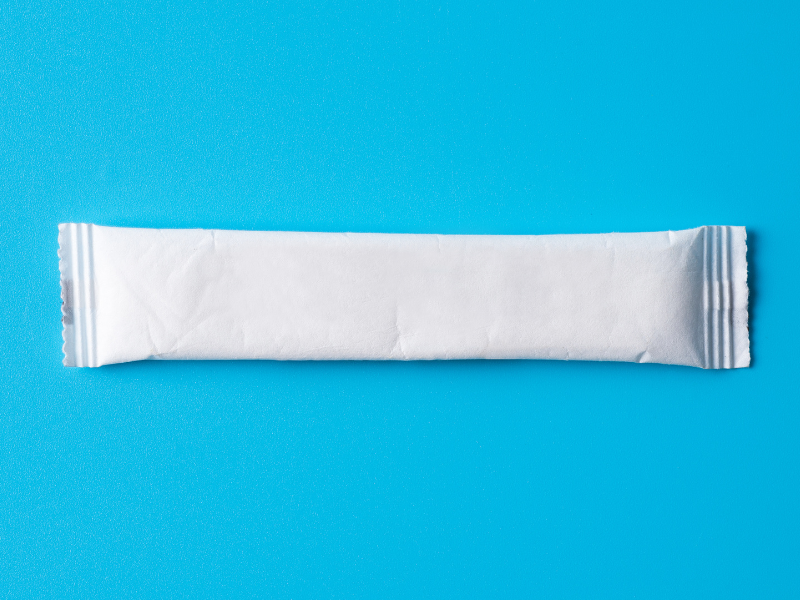


It’s now well-known that consuming too much sugar can result in numerous issues and conditions, and hence we can witness the surge of no-sugar and low-calorie sweeteners being incorporated into diets. Aspartame and Sucralose are two of the most popular sugar replacements, and if you’re considering them as part of your daily diet, it’s best to know all about them before making your choice. So read more as we spill nutritional hacks and help you decide on your choices for the no-sugar lifestyle.
Understanding Sugar Substitutes
Sugar substitutes, also known as artificial sweeteners, were launched as an alternative to sweeten food and beverages, being relatively healthier than sugar in the amount of calories it carries. You can commonly find them in food labelled as sugar-free or diet sodas and beverages, becoming highly popular amongst those looking to watch their carb intake or blood sugar levels, as opposed to sugar-sweetened beverages.
What is Sucralose?

Sucralose was approved by the FDA and launched in the year 1998, and you most likely know it by its brand name Splenda. It’s a zero calorie sweetener derived from sugar and is modified by replacing hydrogen and oxygen groups with chlorine atoms to prevent metabolism.
Because of its origin from real sugar, it’s known to offer a more natural taste devoid of any aftertaste. While sucralose itself has zero calories, it’s 600 times sweeter than sugar and so it’s blended with maltodextrin or dextrose, which has some minimal amount of carbs [1].
What is Aspartame?

Aspartame was approved by the FDA in 1981 and is a low-calorie, synthetic sweetener. Made from two amino acids, aspartic acid and phenylalanine, it is about 200 times sweeter than table sugar [2]. The most common brand names are Equal, NutraSweet and Sugar Twin, and these contain some fillers that pack on a few calories.
No-sugar diet you can try:
No Sugar No Flour Diet: The Ultimate Fat-Burning Solution
The No Added Sugar Diet: What Is It and Who Is It For?
Key Differences and Similarities of Artificial Sweeteners
Let’s first dive into the similarities between them [3]. Approved by the FDA as food additives, they’re both synthetic sugar substitutes that are consumed for a reduced calorie intake. Both of them are significantly sweeter than sugar (aspartame 200 times more, sucralose 600 times more) and are often blended with other ingredients, which gives them a few extra added calories. They both has distinct chemical structures and taste profiles.
Now for the differences [3]: While aspartame contains a few calories, sucralose is totally calorie-free. The body breaks down aspartame, but it does not metabolize sucralose. The former is mostly found in diet sodas, artificially sweetened beverages, gums, and other sugar-free products, while the latter is predominantly used for cooking and baking. This is because aspartame does not have much heat stability, and its sweetness is broken down when heated, while sucralose can remain stable. There’s also a key difference in how much it is recommended to consume each of these artificial sweeteners according to your body weight.
Health Effects of Artificial Sweeteners
Artificial sweeteners like aspartame and sucralose are widely used as sugar substitutes, but their long-term effects on health continue to be debated: The World Health Organization even announced that aspartame could be possibly carcinogenic [4]. While major health organizations, including the European Food Safety Authority (EFSA), have reviewed extensive research and deemed them safe within recommended limits, there are still some concerns that are worth considering [5]:

Potential Health Risks
- Cancer Concerns: Early speculation linked aspartame to brain cancer, but multiple studies have found no credible evidence to support this claim.
- Digestive Discomfort: Some people report experiencing headaches or digestive issues, such as diarrhea, after consuming artificial sweeteners.
- Impact on Gut Bacteria: Animal studies suggest that these sweeteners might disrupt gut bacteria, but human studies have yet to confirm any significant effects.
- Blood Sugar and Metabolism: Research on the metabolic effects of artificial sweeteners is mixed. Some studies suggest aspartame may contribute to glucose intolerance, particularly in individuals with obesity, while others indicate that sucralose could support some weight loss when used as a sugar replacement.
- Inflammation Risks: Long-term use of aspartame has been linked to increased inflammation, which may play a role in chronic conditions like diabetes and heart disease.
You may also like:
The Ultimate 21-Day Anti-Inflammatory Diet [PDF]
Healthy Ice Cream Recipes: 10 Guilt-Free, Vegan and Low Sugar Options
Sucralose or Aspartame: Which is Better?

There are pros and cons for both, so this totally depends on what your individual health needs or dietary preferences are. They are both FDA-approved but have different recommended safety limits: for aspartame it’s 75 packets while for sucralose it’s 23. If you suffer from PKU or schizophrenia, aspartame has been associated with mood swings, headaches, and kidney strain, so it might be best to avoid that. Sucralose, on the other hand, has been linked with inflammation and issues with gut health.
When exposed to cooking heat, aspartame loses its sweetness. Sucralose remains stable but may break down into harmful compounds. When it comes to choosing, it’s a dilemma: If you’re suffering from schizophrenia or PKU, it might be best to stick with sucralose, but if your gut health is a concern, you can choose aspartame. Other artificial sweeteners, like Saccharin and Neotame, are also available.
For more nutritional hacks:
What Happens When You Drink Lemon Water for 7 Days: Benefits & Effects
Why I Stopped Eating Oatmeal: A Deeper Look Into the Popular Breakfast Choice
Conclusion
Artificial sweeteners have become popular additions to people’s diets to help curb weight gain and maintain body weight. However, be careful to regulate your sucralose and aspartame intake and consult your physician or dietician. While they may be useful for reducing sugar intake, it’s essential to be aware of their potential health effects and consider alternative sweeteners. For more tips and nutritional hacks, check out the JustFit app!
Which is healthier, sucralose or aspartame?
What are the negatives of sucralose?
What is the safest artificial sweetener to use?
Czarnecka, K., Pilarz, A., Rogut, A., Maj, P., Szymańska, J., Olejnik, Ł., & Szymański, P. (2021). Aspartame-True or False? Narrative Review of Safety Analysis of General Use in Products. Nutrients, 13(6), 1957. Available at: https://doi.org/10.3390/nu13061957 FDA. (2025, February 27). Aspartame and other sweeteners in food. U.S. Food and Drug Administration. Available at: https://www.fda.gov/food/food-additives-petitions/aspartame-and-other-sweeteners-food Mayo Foundation for Medical Education and Research. (2023a, January 10). Pros and cons of artificial sweeteners. Mayo Clinic. Available at: https://www.mayoclinic.org/healthy-lifestyle/nutrition-and-healthy-eating/in-depth/artificial-sweeteners/art-20046936 Schiffman, S. S., & Rother, K. I. (2013). Sucralose, a synthetic organochlorine sweetener: overview of biological issues. Journal of toxicology and environmental health. Part B, Critical reviews, 16(7), 399–451. Available at: https://doi.org/10.1080/10937404.2013.842523 World Health Organization. (2023, June 14). Aspartame hazard and risk assessment results released. World Health Organization. Available at: https://www.who.int/news/item/14-07-2023-aspartame-hazard-and-risk-assessment-results-released#:~:text=Assessments%20of%20the%20health%20impacts,40%20mg/kg%20body%20weight.





